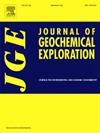Indicator element selection and lithological mapping using deep learning methods in the Dahongliutan area, NW China
IF 3.4
2区 地球科学
Q1 GEOCHEMISTRY & GEOPHYSICS
引用次数: 0
Abstract
Rare metal resources are extensively used in the emerging energy field, making the security and sustainability of rare metal supply chains critical issues. Pegmatite-type rare metal deposits are a significant source of rare metal resources. Geochemistry is one of the most direct and effective methods of mineral exploration. In this study, whole-rock geochemical data from the Akesayi region, located in the Western Kunlun area of China, were used to identify the indicative elements of pegmatite automatically. Based on the stream sediment geochemical data, various deep learning models have been employed to achieve automatic lithological identification of the area. The results indicate that a novel interpretable model using SHapley Additive exPlanations (SHAP) and eXtreme Gradient Boosting (XGBoost) was employed to select indicative elements for the pegmatite in the Akesayi region, identifying Ta and Rb as key elements. The state-of-the-art application of deep-learning algorithms for lithological mapping has proven to be highly effective. Among the four approaches, the ensemble strategy integrating 1D convolutional neural networks, 2D![]() 3D convolutional neural networks, and dual-branch neural networks yields the best lithological mapping results. This approach resulted in a total classification accuracy of 90.422 %, an average accuracy of 90.502 %, a Kappa coefficient of 89.643 %, and a user accuracy of 65.530 % for the pegmatite lithological unit. These results demonstrate that the proposed model can provide robust technical support for the exploration of rare metal pegmatites in regions with challenging natural conditions and limited research.
3D convolutional neural networks, and dual-branch neural networks yields the best lithological mapping results. This approach resulted in a total classification accuracy of 90.422 %, an average accuracy of 90.502 %, a Kappa coefficient of 89.643 %, and a user accuracy of 65.530 % for the pegmatite lithological unit. These results demonstrate that the proposed model can provide robust technical support for the exploration of rare metal pegmatites in regions with challenging natural conditions and limited research.
利用深度学习方法在中国西北部大红柳滩地区选择指示元素并绘制岩性图
稀有金属资源被广泛应用于新兴能源领域,因此稀有金属供应链的安全性和可持续性成为关键问题。伟晶岩型稀有金属矿床是稀有金属资源的重要来源。地球化学是最直接有效的矿产勘探方法之一。本研究利用中国西昆仑地区阿克萨依地区的全岩地球化学数据,自动识别伟晶岩的指示元素。基于流体沉积物地球化学数据,采用多种深度学习模型实现了该地区岩性的自动识别。结果表明,使用 SHapley Additive exPlanations(SHAP)和 eXtreme Gradient Boosting(XGBoost)建立的新型可解释模型可为阿克萨伊地区的伟晶岩选择指示元素,并确定 Ta 和 Rb 为关键元素。事实证明,将深度学习算法应用于岩性制图是非常有效的。在四种方法中,整合了一维卷积神经网络、二维三维卷积神经网络和双分支神经网络的集合策略产生了最佳的岩性绘图结果。该方法对伟晶岩岩性单元的总分类准确率为 90.422%,平均准确率为 90.502%,卡帕系数为 89.643%,用户准确率为 65.530%。这些结果表明,所提出的模型可以为自然条件恶劣、研究有限地区的稀有金属伟晶岩勘探提供强有力的技术支持。
本文章由计算机程序翻译,如有差异,请以英文原文为准。
求助全文
约1分钟内获得全文
求助全文
来源期刊

Journal of Geochemical Exploration
地学-地球化学与地球物理
CiteScore
7.40
自引率
7.70%
发文量
148
审稿时长
8.1 months
期刊介绍:
Journal of Geochemical Exploration is mostly dedicated to publication of original studies in exploration and environmental geochemistry and related topics.
Contributions considered of prevalent interest for the journal include researches based on the application of innovative methods to:
define the genesis and the evolution of mineral deposits including transfer of elements in large-scale mineralized areas.
analyze complex systems at the boundaries between bio-geochemistry, metal transport and mineral accumulation.
evaluate effects of historical mining activities on the surface environment.
trace pollutant sources and define their fate and transport models in the near-surface and surface environments involving solid, fluid and aerial matrices.
assess and quantify natural and technogenic radioactivity in the environment.
determine geochemical anomalies and set baseline reference values using compositional data analysis, multivariate statistics and geo-spatial analysis.
assess the impacts of anthropogenic contamination on ecosystems and human health at local and regional scale to prioritize and classify risks through deterministic and stochastic approaches.
Papers dedicated to the presentation of newly developed methods in analytical geochemistry to be applied in the field or in laboratory are also within the topics of interest for the journal.
 求助内容:
求助内容: 应助结果提醒方式:
应助结果提醒方式:


